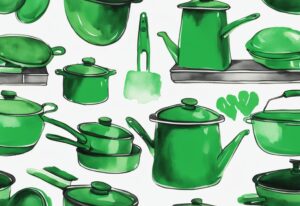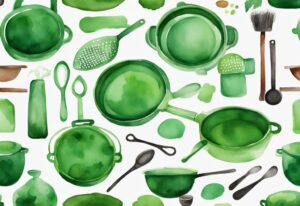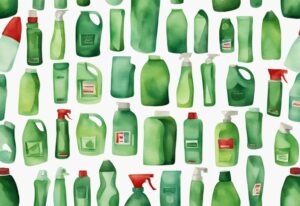Discover the Truth: Are Hexclad Pans Non-Toxic? An Expert Analysis.
Ever heard about HexClad pans and found yourself pondering, are they truly non-toxic? You’re not alone. It’s about time we scrutinize the materials and safety claims of these widely-discussed pans. In the following paragraphs, I’m going to dive deep into the details of HexClad pans, critically addressing their non-toxic credentials.
Understanding what’s in our cookware is as crucial as knowing what’s in our meals. That’s why I’m here to guide you in making more conscious choices for both your kitchen and your well-being.
Stick with me, and together we’ll uncover not only the truth behind HexClad pans but also how they stack up against other non-toxic alternatives for your kitchen.
HexClad Pans: What You Need to Know
HexClad pans are celebrated for merging nonstick convenience with stainless steel resilience. But how do they measure up in terms of safety, particularly when we’re concerned about living a non-toxic lifestyle?
Breaking Down the HexClad Materials
HexClad pans boast a unique construction. Imagine an aluminum core sandwiched between layers of stainless steel. This design ensures durability and optimal heat distribution, crucial for those perfect cooking results. On top of that, the surface is coated with a nonstick PTFE layer, enhanced by a hexagonal lattice made of stainless steel.
The combination is quite innovative—it offers the ease of nonstick while keeping the robustness of stainless steel. For extra durability, this nonstick coating includes a Japanese formulation infused with diamond dust. It’s a thoughtful addition that significantly boosts the wear resistance of the coating, ensuring the pans maintain their nonstick properties for longer periods.
The Unique Features of HexClad Pans
One standout feature of HexClad pans is their ability to distribute heat evenly across the surface, minimizing those pesky hotspots. Consistent cooking results are within reach with these pans. They’re also versatile, compatible with various cooktops, including gas, electric, and induction, thanks to a magnetic steel base.
Safety and ergonomic design are priorities too. With stay-cool handles, you can maneuver the pans without risking burns. Plus, they are dishwasher-safe, making cleanup a breeze.
Worried about durability? HexClad pans come with a lifetime warranty against manufacturing defects. It’s reassuring to know, although it’s important to follow the manufacturer’s guidelines to avoid voiding the warranty from improper use.

Evaluating HexClad’s Non-Toxic Claims
When assessing the truth behind HexClad’s non-toxic claims, it’s essential to dive deep into the specifics.
How FDA Approvals Impact HexClad’s Safety
HexClad pans come with an FDA-approved PTFE coating, which means they adhere to rigorous safety guidelines. This approval ensures that, when used below the threshold of 500°F, the cookware remains non-toxic. Above this limit, PTFE can release harmful fumes, making temperature management crucial. Adhering to FDA standards, HexClad showcases their commitment to providing safer cookware, especially for those who prioritize non-toxic cooking environments. It’s like having that trusty friend who always steers you in the right direction!
Understanding the Role of PTFE in HexClad Pans
PTFE, or polytetrafluoroethylene, forms the backbone of HexClad’s nonstick surface, offering unparalleled convenience and durability. This “forever chemical” is celebrated for its smooth, nonstick functionality, yet it’s vital to use it correctly. HexClad pans are safe as long as you cook below 500°F; going beyond that can degrade PTFE, releasing toxic fumes. Although it sounds daunting, once you get the hang of it, it’s straightforward. This highlights the significance of proper cooking practices to keep your kitchen toxic-free while enjoying the ease of nonstick cooking.
HexClad’s PFOA-Free Stance: A Deep Dive
One of the most reassuring aspects of HexClad pans is their PFOA-free pledge. PFOA, known for its severe health risks including cancer and liver damage, has no place in HexClad cookware. By removing PFOA, HexClad aligns with stringent U.S. FDA and California Prop 65 standards, emphasizing their dedication to non-toxic cookware. This move significantly lowers the risk of exposure to harmful toxins, making your cooking healthier. To understand more about the claims surrounding non-toxic cookware and the potential pitfalls, you can learn more [here](https://www.consumerreports.org/toxic-chemicals-substances/you-cant-always-trust-claims-on-non-toxic-cookware-a4849321487/?srsltid=AfmBOooOekR2umpTgjzHfs6npvSjD2XPLKoGIN0kTc4MplvIGHpFgxRG). It’s a comforting thought, knowing that HexClad’s commitment extends beyond mere performance to genuinely caring for your well-being. This PFOA-free assurance directly answers the pressing question: are HexClad pans non-toxic? Here’s to safer, healthier, and more enjoyable cooking experiences!
HexClad Pans: The Good and the Potentially Concerning
HexClad pans have garnered attention for their innovative design and the balance they strike between traditional and nonstick functionalities. Below, we delve into the health benefits they offer and explore some concerns related to their materials.
The Health Advantages of Using HexClad Pans
HexClad pans are crafted using food-safe materials like stainless steel and aluminum, ensuring that your cooking surfaces are secure and reliable. The unique construction of these pans, featuring an aluminum core between layers of stainless steel, contributes to efficient heat distribution. This minimizes the risk of hotspots, making meal preparation safer and more consistent.
The nonstick properties of HexClad pans are particularly advantageous for health-conscious cooks. The enhanced nonstick surface reduces the need for excessive oils and fats, facilitating healthier cooking methods. This can be especially beneficial for those aiming to lower their calorie intake without compromising on the quality of their meals.
The stainless steel lattice pattern integrated within the nonstick surface elevates the durability of the pans. This design element not only prolongs the lifespan of the nonstick coating but also ensures that the surface remains smooth and resistant to peeling or chipping over time. Together, these features make HexClad pans a robust and health-promoting option for home chefs.
The Grey Area: Discussing PTFE in HexClad Pans
Addressing the question are Hexclad pans non toxic inevitably brings attention to the presence of PTFE in their nonstick coating. While HexClad successfully eliminates PFOA, a chemical linked to severe health risks, PTFE remains a topic of concern. PTFE, or polytetrafluoroethylene, is responsible for the nonstick properties but requires careful usage to avoid potential issues.
When used correctly, PTFE-coated surfaces are deemed safe by the FDA. Maintaining cooking temperatures below 500°F is crucial to prevent the PTFE from degrading and releasing toxic fumes. This precaution ensures that the cookware remains non-toxic and safe for everyday use.
However, the environmental and health implications of PTFE cannot be entirely ignored. PTFE is a persistent chemical, meaning it doesn’t break down easily, which raises questions about its long-term impact. Responsible use and stringent maintenance are therefore essential to maintain the safety and efficacy of HexClad pans.
How the Lifespan of HexClad Pans Affects Non-Toxicity
One of the significant selling points of HexClad pans is their longevity. The combination of stainless steel and aluminum in their construction, along with a well-engineered nonstick surface, ensures that these pans are built to last. A longer lifespan means less frequent replacement, which not only saves money in the long run but also minimizes environmental waste.
The durability of the nonstick surface, enhanced by the stainless steel lattice, plays a pivotal role in maintaining the pans’ non-toxic status. As long as the nonstick coating remains intact and undamaged, the risk of chemical leaching and toxin release stays minimal. Responsible use—such as avoiding metal utensils and adhering to recommended temperature limits—further extends the lifespan of these coatings, ensuring that the pans remain safe over time.
By investing in quality cookware like HexClad and following proper maintenance guidelines, users can enjoy the dual benefits of health and durability. This helps solidify the perception that HexClad pans, when used correctly, can indeed be considered a non-toxic option despite the presence of PTFE.
How HexClad Pans Compare to Other Non-Toxic Cookware
HexClad Pans offer a robust option in the non-toxic cookware market. Their construction, combining a stainless steel lattice integrated with a durable PTFE coating, ensures longevity and consistent cooking performance. Let’s dive into how they stack up against other popular non-toxic cookware choices.
HexClad Pans vs Ceramic Cookware: A Safety Comparison
Ceramic cookware has become a favored choice for those avoiding PTFE, attracting health-conscious cooks. However, ceramic coatings tend to wear down over time, which can compromise their effectiveness.
In contrast, HexClad pans feature a durable design with an aluminum core surrounded by stainless steel layers. This not only boosts their durability but also ensures even heat distribution, avoiding those frustrating hot spots during cooking.

HexClad also shines in the non-stick department. Ceramic coatings often lose their nonstick properties more quickly, resulting in food sticking to the pan. HexClad’s Japanese formulation, enhanced with diamond dust, offers a lasting nonstick experience. This efficiency means you can use less oil, aligning with health-conscious and non-toxic cooking practices. So, while ceramic cookware might be PTFE-free, HexClad excels in durability and nonstick performance.
Stainless Steel vs HexClad: Which is Less Toxic?
Stainless steel cookware is a go-to for many, valued for its absence of nonstick coatings and associated PTFE concerns. However, it’s worth noting that stainless steel can leach metals like nickel and chromium, especially when cooking acidic foods, which poses health risks over time.
HexClad pans strike a balance by offering the benefits of stainless steel—such as durability and impressive heat retention—along with a convenient nonstick surface. Proper temperature management is key; keeping cooking temperatures below 500°F ensures the PTFE coating remains stable and safe. The integration of a stainless steel lattice within the PTFE layer bolsters the coating’s integrity, reducing degradation risks. Thus, while stainless steel demands caution against metal leaching, HexClad provides a balanced, non-toxic cooking solution with added nonstick advantages.
Traditional Non-Stick Pans and HexClad: A Side-By-Side
Traditional non-stick pans often contain both PTFE and PFOA, chemicals linked to serious health issues. PFOA, in particular, has sparked enough concern to be phased out from many products.
HexClad bypasses this problem by being completely PFOA-free, meeting stringent safety standards set by authorities such as the FDA and California Prop 65. The unique construction of HexClad—the PTFE layer reinforced with a stainless steel hexagonal lattice—ensures enhanced durability and safety over conventional non-stick pans. This structure not only extends the lifespan of the nonstick surface but also offers protection against high temperatures.
Traditional non-stick pans can degrade more quickly, potentially releasing toxic fumes when overheated. By eliminating PFOA and utilizing durable materials, HexClad presents a safer and more long-lasting option for non-toxic cooking.
Guidelines for Safe Usage of HexClad Pans
Maintaining the non-toxic nature of HexClad pans involves understanding and managing various aspects of their use, including temperature control, regular maintenance, and proper cleaning techniques. Here’s a closer look at how to keep your HexClad pans safe and non-toxic.
Managing Temperature for PTFE-Coated HexClad Pans
When it comes to cooking with HexClad pans, managing temperature is of paramount importance. These pans feature a PTFE-coated surface, which helps maintain their non-toxic properties. To ensure these pans remain a safe option in your kitchen, it’s crucial to keep cooking temperatures below 500°F. Exceeding this limit may lead to the degradation of the PTFE layer, potentially releasing harmful fumes.
Additionally, avoid preheating an empty pan on high heat, as this can swiftly elevate temperatures beyond safe limits. By effectively monitoring and controlling heat levels, you not only maintain the integrity of the nonstick surface but also enjoy a safe cooking experience every time.
Keeping Your HexClad Pans Non-Toxic Through Maintenance
Proper maintenance is key to preserving the non-toxic characteristics of your HexClad pans over time. Regular upkeep involves a few essential practices: avoid overheating the pan, and do not use metal utensils that could scratch the nonstick surface. Overheating can damage the PTFE layer, while abrasive metal utensils can undermine the pan’s effectiveness, potentially making it unsafe.
Periodic re-seasoning also plays a crucial role in maintaining surface integrity. This process is simple: applying a light layer of oil and heating the pan can help restore its nonstick properties. By doing so, you ensure the pan continues to perform efficiently and safely.
Ensuring Non-Toxicity with Proper Cleaning Techniques
The non-toxic quality of your HexClad pans also hinges on how you clean them. Using non-abrasive sponges can effectively clean the surface without causing damage, while soaking the pans in soapy water helps to loosen any stubborn, stuck-on residue.
Regular and thorough cleaning prevents residue build-up, which can harbor harmful bacteria or mold. This straightforward routine not only keeps your pans clean and safe but also extends their lifespan. Following these cleaning guidelines, you contribute significantly to maintaining the non-toxic and optimal condition of your HexClad pans for everyday use.
HexClad Pans and Their Impact on Health and Environment
Finding the perfect cookware that is both effective and safe can be a dilemma for those committed to sustainable living. When it comes to the question, “Are HexClad pans non-toxic?” it’s crucial to look at the details.
The Environment and PTFE: What You Should Know
One of the primary concerns surrounding HexClad pans is their use of PTFE as a nonstick coating. PTFE, while making cooking and cleaning a breeze, also poses significant environmental challenges. This synthetic chemical is notoriously resistant to degradation. Imagine it sitting in a landfill for decades, refusing to break down. It’s a sobering thought, isn’t it?
Moreover, the non-recyclability of PTFE-coated items makes matters worse. Since most conventional recycling programs can’t handle such synthetic coatings, these pans contribute to our growing landfill crisis once they’ve outlived their utility. It’s a cycle that contradicts the principles of a non-toxic living approach.
HexClad Manufacturing: Towards Green Production
With the rise of eco-conscious consumers, transparency in sustainability practices is more important than ever. Unfortunately, HexClad remains opaque about its sustainability efforts. For those of us who prioritize non-toxic and environmentally friendly products, this lack of information is troubling.

Imagine going to a store and finding no details about how a product you intend to invest in impacts the planet. It’s essential to advocate for brands to adopt sustainable manufacturing standards—using eco-friendly materials and minimizing waste. Without clear commitments from HexClad in these areas, it leaves a lot to be desired for those of us striving for green living.
What to Do with Your HexClad Pans After Their Lifespan Ends
Disposing of PTFE-coated cookware like HexClad pans can be quite the conundrum due to their synthetic chemical coatings. Simply tossing them in your regular rubbish bin isn’t an option we should consider if we care about reducing our environmental footprint.
Instead, exploring specialized recycling centers capable of handling such cookware is essential. Sometimes this involves a bit of investigation—reaching out to local resources or municipal bodies to locate these facilities. This extra step might seem daunting, but it aligns perfectly with our principles of non-toxic living and responsible consumption, making sure that we’re minimizing PTFE’s potential harm.
Taking these steps ensures that every effort we make contributes to a healthier, more sustainable world. Are HexClad pans non-toxic? Well, navigating the balance between convenience and ecological responsibility is part of the answer. Let’s continue to push for more transparent, eco-friendly options in our kitchens and beyond.
Conclusion: Are HexClad Pans Truly Non-Toxic?
HexClad pans are marketed as a non-toxic cooking solution, boasting freedom from harmful chemicals like PFOA. This positions them positively among nonstick cookware options. However, it’s important to explore the full picture—particularly the role of PTFE.
HexClad incorporates PTFE to achieve its renowned nonstick properties, resulting in a product that requires responsible use and proper care to maintain its non-toxic status. PTFE is an FDA-approved material, safe when used below 500°F. Heat management is crucial; overheating can cause PTFE to degrade and release toxic fumes, representing a risk if the cookware is not handled appropriately.
Comparatively, HexClad pans offer a safer alternative to many traditional nonstick options, which often include PFOA—known for serious health risks. The design of HexClad, featuring a unique blend of stainless steel and an aluminum core, not only ensures even heat distribution but also increases the pans’ longevity and safety when used correctly.
Continuous evaluation and adherence to usage guidelines are vital. Regular cleaning, avoiding metal utensils, and maintaining moderate cooking temperatures are some practices that ensure these pans’ long-term safety. While no nonstick cookware is without its drawbacks, HexClad provides a robust, safer option suited to modern, health-conscious kitchens.
FAQs
Are There Chemical Hazards in HexClad Pans?
The primary concern with HexClad pans revolves around the PTFE coating, which can release toxic fumes if overheated. HexClad discloses the presence of PTFE, allowing users to take necessary precautions to use them safely.
What Sets HexClad Apart from Other Non-Stick Pans?
HexClad combines the durability of stainless steel with the nonstick ease of PTFE. Being free of PFOA, these pans reduce exposure to harmful toxins compared to traditional non-stick cookware.
How Safe is the PTFE Coating on HexClad Pans?
The PTFE coating on HexClad pans is FDA-approved for safety when used correctly, maintaining temperatures below 500°F. The stainless steel lattice helps protect the nonstick surface, prolonging its safe usage.
How can You Ensure Your HexClad Pans Stay Non-Toxic?
To keep HexClad pans non-toxic, maintain moderate cooking temperatures, avoid using metal utensils, and follow prescribed maintenance guidelines. Clean the pans regularly but avoid harsh chemicals that may damage the nonstick layer.
Is It Possible to Recycle HexClad Pans?
Recycling HexClad pans is challenging due to the non-recyclable PTFE coating. Certain specialized recycling centers might accept them. Check local recycling policies or contact the manufacturer for recommendations.
Hi, I’m Olivia Green, the voice behind nontoxicways.com. I’m passionate about helping you make the shift to a healthier, non-toxic lifestyle without feeling overwhelmed. I love sharing my personal journey, from small changes to big transformations, along with practical tips that make it all feel doable. My goal is to inspire and guide you toward a lifestyle that benefits both your well-being and the planet. Let’s take this journey together, one simple step at a time!














Post Comment